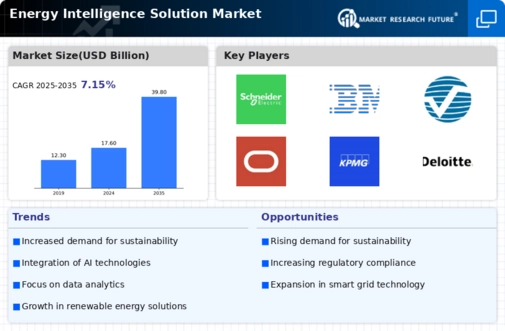North America : Innovation and Investment Hub
North America is the largest market for Energy Intelligence Solutions, holding approximately 45% of the global share. The region's growth is driven by increasing energy efficiency regulations, technological advancements, and a strong focus on sustainability. The U.S. and Canada are the primary contributors, with significant investments in smart grid technologies and renewable energy initiatives. Regulatory frameworks, such as the Clean Power Plan, further catalyze market expansion.
The competitive landscape in North America is robust, featuring key players like Honeywell, General Electric, and IBM. These companies are at the forefront of innovation, offering advanced solutions that cater to diverse energy needs. The presence of major tech firms and startups fosters a dynamic environment for collaboration and development. As energy demands evolve, the region is poised for continued growth in energy intelligence solutions, driven by both public and private sector initiatives.
Europe : Sustainability and Regulation Focus
Europe is the second-largest market for Energy Intelligence Solutions, accounting for around 30% of the global market share. The region's growth is propelled by stringent environmental regulations, ambitious climate goals, and a strong push towards renewable energy sources. Countries like Germany and France lead the charge, implementing policies that promote energy efficiency and smart technologies. The European Green Deal is a significant regulatory catalyst, aiming to make Europe the first climate-neutral continent by 2050.
Leading countries in Europe, such as Germany, France, and the UK, are home to major players like Siemens and Schneider Electric. The competitive landscape is characterized by a mix of established firms and innovative startups, all striving to meet the increasing demand for sustainable energy solutions. Collaborative efforts between governments and private sectors enhance the development of cutting-edge technologies, positioning Europe as a leader in the energy intelligence market.
Asia-Pacific : Emerging Market Potential
Asia-Pacific is witnessing rapid growth in the Energy Intelligence Solutions market, holding approximately 20% of the global share. The region's expansion is driven by increasing energy consumption, urbanization, and government initiatives aimed at enhancing energy efficiency. Countries like China and India are at the forefront, implementing policies that support renewable energy and smart grid technologies. The region's diverse energy landscape presents both challenges and opportunities for market players.
China is the largest market in the region, followed by India, both of which are investing heavily in energy intelligence solutions. The competitive landscape includes key players like Wipro and Enel X, alongside local firms that are innovating to meet regional demands. As governments prioritize sustainable energy practices, the Asia-Pacific market is expected to grow significantly, attracting investments and fostering technological advancements.
Middle East and Africa : Resource-Rich Opportunities
The Middle East and Africa region is emerging as a significant player in the Energy Intelligence Solutions market, holding about 5% of the global share. The growth is driven by the need for energy diversification, sustainability initiatives, and investments in smart technologies. Countries like the UAE and South Africa are leading the way, implementing strategies to enhance energy efficiency and reduce carbon footprints. The region's vast natural resources provide a unique opportunity for developing innovative energy solutions.
In the Middle East, the UAE is spearheading initiatives to transition towards renewable energy, while South Africa is focusing on improving its energy infrastructure. The competitive landscape features both international and local players, with companies like SAP and Deloitte actively participating in the market. As the region continues to invest in energy intelligence solutions, it is poised for growth, driven by both governmental support and private sector innovation.


















Leave a Comment